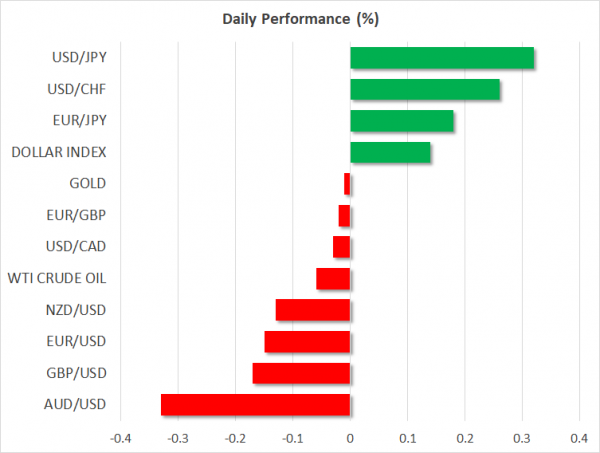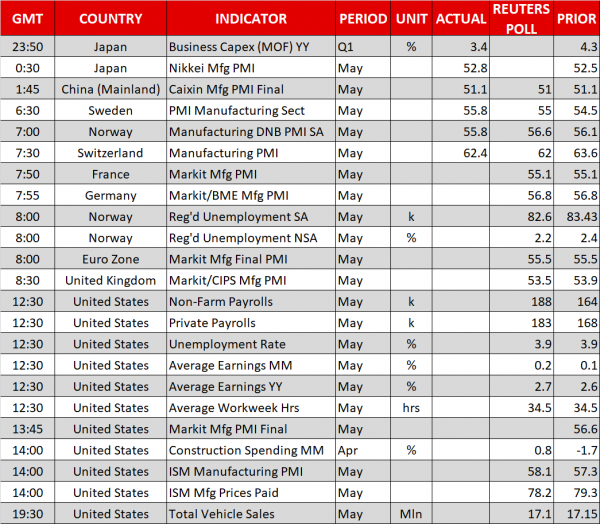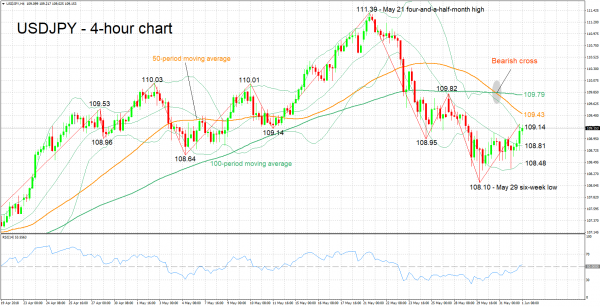Here are the latest developments in global markets:
FOREX: The US dollar index is a little more than 0.1% higher on Friday, ahead of the release of the always-important US employment report at 1230 GMT. Elsewhere, the Canadian dollar dived yesterday following discouraging news on the trade front, while the euro continued to regain ground as Italy’s political impasse came to an end.
STOCKS: Wall Street closed lower on Thursday, as an escalation of trade tensions suppressed risk appetite. The Dow Jones fell by 1.02%, while the S&P 500 and the Nasdaq Composite shed 0.69% and 0.27% respectively. That said, futures tracking the Dow, S&P, and Nasdaq 100 are all currently pointing to a notably higher open today, which may be owed to news that a government was finally formed in Italy, ending a prolonged political vacuum. In Asia, Japan’s Nikkei 225 declined 0.14% but the Topix rose by 0.1%, while in Hong Kong, the Hang Seng climbed by 0.21%. Europe was a much more optimistic story, with futures tracking all the major indices being well-into the positive territory. In particular, the Italian FTSE MIB and the Spanish IBEX 35 are expected to open higher, with futures tracking them being up by 2.6% and 1.07% respectively, as political risks in both nations appeared to be easing.
COMMODITIES: Oil prices are practically unchanged on Friday, after posting hefty losses in the previous session. Both WTI and Brent crude slumped as the announcement of tariffs by the US clouded the outlook for global trade, something that could hurt oil demand moving forward. Even a larger-than-anticipated drawdown in the weekly EIA crude inventory data was not enough to support prices for more than a few minutes. In precious metals, gold prices are also nearly flat today around $1,300 per ounce. The yellow metal finished the day lower yesterday despite trade risks coming back to the forefront; it started sliding after it found fresh sell orders near its 200-day moving average once again. That zone has been acting as a reliable resistance barrier recently, and as long as the price action remains below it, the metal’s technical outlook stays negative.
Major movers: Global trade risks heighten as European political risks fade
The “trade war” narrative got yet another chapter yesterday, after the US announced it will proceed with slapping tariffs on steel and aluminum imports from the EU, Canada, and Mexico. The EU said it would announce its own counter-tariffs within hours, which will be aimed at signature US products such as bourbon and Harley Davidson motorbikes. These are predominantly made in Republican states, thus targeting Trump’s voter base. Mexico and Canada replied in similar fashion to the EU, drawing a warning from President Trump that the US will agree to a fair NAFTA deal, or “no deal at all”. Both the Canadian dollar and the Mexican peso slumped, while the US dollar remained largely unfazed.
While the situation has clearly escalated, and tit-for-tat tariffs will be announced soon by nations who have long been traditional US allies, the market response was surprisingly calm. Sure, US stock markets ended the day lower and haven currencies like the yen gained a little ground against the dollar, but the magnitude of these moves was nothing like one would expect in case investors were pricing-in a material deterioration in global trade. This suggests investors still view these moves as “hardball” negotiating tactics from the US aimed at drawing out concessions, and believe the situation will eventually be resolved through talks instead of evolving into a full-fleshed trade war.
Moving forward, things could get worse before they get better. The US is currently investigating whether it should introduce tariffs on car imports, something that would disproportionally single out car-making nations like Germany, and set the stage for more retaliatory measures by the EU.
In Europe, political risks appear to be fading at a very rapid pace. A coalition government has been agreed in Italy after several months of uncertainty. The two anti-establishment parties agreed on a new economy minister, after their previous pick was rejected by the Italian President for being euro-skeptic (he will now serve as foreign minister). Italian bond yields fell sharply, while the euro continued to recover ground and looks ready to close the week in positive territory against the dollar.
In Spain, even though PM Rajoy will probably lose a no-confidence vote today, a political deadlock will likely be avoided as the leader of the socialist party, Pedro Sanchez, appears to have enough votes to become the new PM.
Day ahead: US employment report firmly in focus; trade developments also eyed
The US jobs report dominates the attention out of today’s releases, while any updates on global trade will also be eyed after the Trump administration’s decision to proceed with the imposition of tariffs on steel and aluminum from countries that are considered traditional US allies.
The Markit’s final release of eurozone manufacturing PMI for May due at 0800 GMT is anticipated to confirm the reading at 55.5. While comfortably above the 50 level, thus denoting expansion, this would also constitute the lowest print since February last year; economic momentum is easing in the euro area.
Politics remain at play in Europe and can affect positioning on the euro. In Italy, the two anti-establishment parties 5-Star Movement and League have come to an agreement on forming a government after all. Meanwhile in Spain, Mariano Rajoy is expected to be ousted from the position of prime minister in a no-confidence vote today in parliament. However, the situation in the country is more of an internal one, rather than pose risks for the rest of Europe – anti-establishment forces are not expected to take power as is the case in Italy.
Manufacturing PMI data for May will also be made public out of the UK, at 0830 GMT. This will be the first and only release – as opposed to the eurozone that also sees the release of preliminary estimates – and therefore it might prove more market moving that the respective eurozone release earlier in the day. The relevant index is projected to further deteriorate, specifically to come in at 53.5 (from 53.9 in April), its lowest since late 2006. A data miss could further push back in time market participants’ expectations for a Bank of England rate hike, consequently exerting selling pressure on sterling.
At 1230 GMT, the focus will turn to the nonfarm payrolls report for May out of the US, which also happens to be the last employment report before the Federal Reserve completes a meeting on monetary policy on June 13. Nonfarm payrolls are forecast to have increased by 188k (vs 164k in April), while the unemployment rate is expected to remain at 3.9%, its lowest since 2000. Most interest though is yet again likely to fall on wage growth which is seen as having the capacity to stoke inflationary pressures. In this respect, average earnings are anticipated to grow at a faster pace in May compared to April on both an annual (2.7% vs 2.6%) and monthly (0.2% vs 0.1%) basis.
Other US data hitting the markets throughout the rest of the day include Markit’s final manufacturing PMI for May (1345 GMT), April’s construction spending figures (1400 GMT), the ISM’s manufacturing PMI for May (1400 GMT), and May’s total vehicle sales (1930 GMT).
The trade war narrative is back after the US decided to proceed with tariffs on steel and aluminum imports from Canada, Mexico and the EU, bringing to an end the two-month exemption period it had granted previously. Some of the parties involved have already retaliated and should the situation escalate, then shock waves might reverberate across international financial markets. It should also be kept in mind that developments are expected to have implications not just for currency markets, but also equity, fixed income and commodities. Also trade-related, US Secretary of Commerce Wilbur Ross will be visiting Beijing on Saturday for more discussions with Vice Premier Liu He. The US and China have also gotten more confrontational ahead of the meeting.
In energy markets, the US Baker Hughes oil rig count is due at 1700 GMT. Also of interest to oil traders, is a planned meeting in Kuwait City on Saturday where Saudi Arabia, Kuwait and the U.A.E. will be discussing supply.
In terms of policymakers’ appearances: Riksbank Governor Stefan Ingves will be talking about current monetary policy issues at 1000 GMT, while Minneapolis Fed President Neel Kashkari – non-voting FOMC member in 2018 – will be participating in a panel discussion at 1255 GMT. However, the topic of discussion is such that renders any market sensitive comments unlikely. Lastly, Bank of England Chief Economist Andy Haldane will be giving a lecture at 1310 GMT.
Technical Analysis: USDJPY looks bullish in the short-term after bounce from 6-week low
USDJPY has advanced after hitting a six-week low of 108.10 on Tuesday. The RSI continues to rise, having crossed above the 50 neutral-perceived level, in favor of a positive picture in the short-term.
An upbeat jobs report out of the US, especially on the wage growth front, is expected to boost the pair. Resistance seems to be taking place at the moment around the upper Bollinger band at 109.14 (this level itself was violated but the area around it seems to still act as a barrier). The regions around the 50-period moving average at 109.43 and the 100-period MA at 109.79 – including the 110 round figure – could act as additional barriers to stronger bullish movement.
Disappointing data out of the US, on the other hand, are likely to push USDJPY lower. Potential support to declines might come around the middle Bollinger line at 108.81 – this is a 20-period MA line –, the lower Bollinger band at 108.48, and the six-week low of 108.10 from earlier in the week.
Other US releases, as well as any safe-haven flows on the back of trade uncertainty, can also move the pair.
















